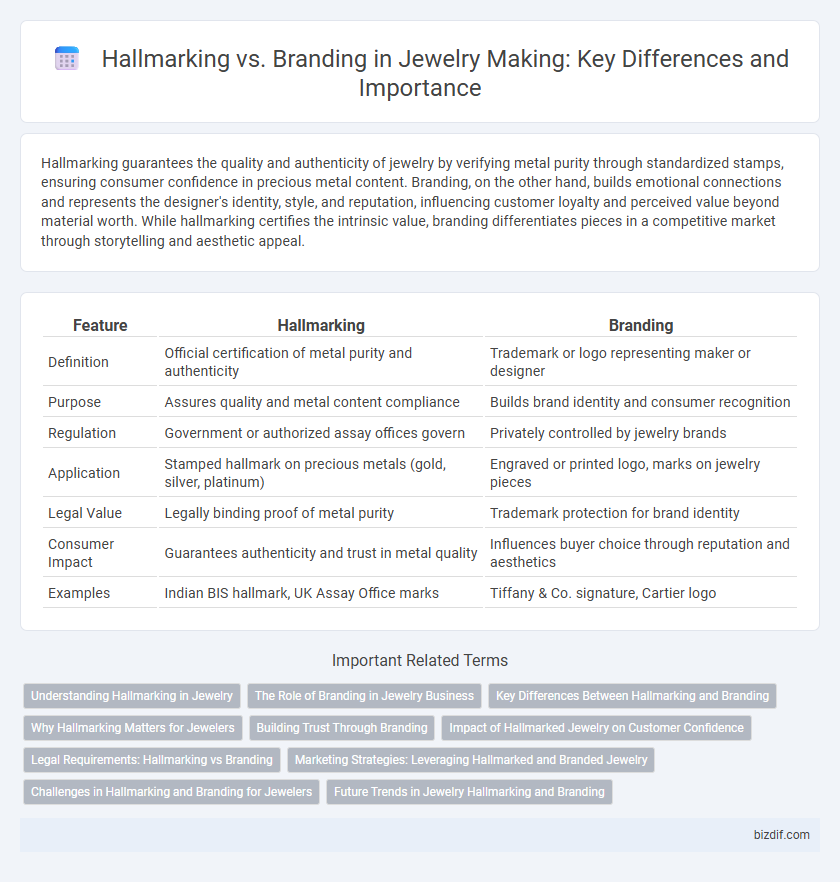Hallmarking guarantees the quality and authenticity of jewelry by verifying metal purity through standardized stamps, ensuring consumer confidence in precious metal content. Branding, on the other hand, builds emotional connections and represents the designer's identity, style, and reputation, influencing customer loyalty and perceived value beyond material worth. While hallmarking certifies the intrinsic value, branding differentiates pieces in a competitive market through storytelling and aesthetic appeal.
Table of Comparison
| Feature | Hallmarking | Branding |
|---|---|---|
| Definition | Official certification of metal purity and authenticity | Trademark or logo representing maker or designer |
| Purpose | Assures quality and metal content compliance | Builds brand identity and consumer recognition |
| Regulation | Government or authorized assay offices govern | Privately controlled by jewelry brands |
| Application | Stamped hallmark on precious metals (gold, silver, platinum) | Engraved or printed logo, marks on jewelry pieces |
| Legal Value | Legally binding proof of metal purity | Trademark protection for brand identity |
| Consumer Impact | Guarantees authenticity and trust in metal quality | Influences buyer choice through reputation and aesthetics |
| Examples | Indian BIS hallmark, UK Assay Office marks | Tiffany & Co. signature, Cartier logo |
Understanding Hallmarking in Jewelry
Hallmarking in jewelry involves the official certification of precious metals, verifying their purity and authenticity through standardized marks applied by authorized assay offices. This process ensures consumer protection by guaranteeing the metal content, such as 18k gold or 925 silver, providing trust and transparency in the market. Unlike branding, which emphasizes a jeweler's reputation and design style, hallmarking focuses solely on metal quality verification, offering a legally recognized standard for buyers.
The Role of Branding in Jewelry Business
Branding in the jewelry business establishes a unique identity that differentiates products in a competitive market, fostering customer loyalty and trust. Unlike hallmarking, which authenticates the metal quality and purity, branding communicates the craftsmanship, style, and story behind each piece, enhancing perceived value. Effective branding strategies drive long-term business growth by creating emotional connections and recognition beyond the basic assurances of hallmarking.
Key Differences Between Hallmarking and Branding
Hallmarking certifies a piece of jewelry's metal purity through official assay offices, ensuring authenticity and consumer protection, while branding focuses on establishing a jewelry maker's identity and reputation through logos and trademarks. Hallmarks are legally regulated marks indicating precious metal content, whereas branding is a marketing strategy to differentiate products in a competitive market. The key difference lies in hallmarking's emphasis on quality verification and legal compliance, contrasted with branding's role in creating customer loyalty and market presence.
Why Hallmarking Matters for Jewelers
Hallmarking matters for jewelers as it guarantees the authenticity and purity of precious metals, protecting both the maker and the consumer from counterfeit or substandard materials. This official certification strengthens customer trust and complies with legal standards, differentiating authentic craftsmanship from branded but potentially uncertified products. Ensuring hallmarking also enhances the jeweler's reputation, promoting transparency and quality assurance in the highly competitive jewelry market.
Building Trust Through Branding
Hallmarking guarantees the authenticity and purity of precious metals, ensuring compliance with legal standards and protecting consumers from counterfeit jewelry. Branding builds long-term trust by creating a consistent identity, emotional connection, and reputation that differentiates a jeweler from competitors. Combining hallmarking with strong branding strategies enhances consumer confidence, driving loyalty and repeat purchases in the jewelry market.
Impact of Hallmarked Jewelry on Customer Confidence
Hallmarked jewelry carries official certification of metal purity, significantly boosting customer confidence by assuring authenticity and quality. This trusted verification reduces the risk of counterfeit products and enhances buyer trust in the jewelry market. Unlike branding, hallmarking provides a standardized guarantee recognized across the industry, directly impacting purchasing decisions.
Legal Requirements: Hallmarking vs Branding
Hallmarking in jewelry making is a legally mandated process that certifies the purity and metal content of precious metals, ensuring consumer protection and compliance with government standards. Branding, by contrast, is a marketing strategy used by jewelry designers and companies to establish brand identity and differentiate products but does not fulfill any legal purity verification requirements. Failure to adhere to hallmarking regulations can result in legal penalties and loss of consumer trust, while branding primarily influences market positioning and customer loyalty.
Marketing Strategies: Leveraging Hallmarked and Branded Jewelry
Hallmarked jewelry guarantees authenticity and quality, serving as a powerful marketing tool to build consumer trust and differentiate products in a competitive market. Branded jewelry, by contrast, emphasizes unique design, brand story, and emotional connection, helping to cultivate customer loyalty and justify premium pricing. Combining hallmarking with branding enables jewelers to leverage verified craftsmanship alongside brand identity, maximizing market appeal and reinforcing both credibility and exclusivity.
Challenges in Hallmarking and Branding for Jewelers
Hallmarking poses challenges for jewelers due to stringent government regulations, varied international standards, and the need for costly, precise testing equipment to guarantee metal purity. Branding efforts face difficulties in differentiating products within a saturated market, building customer trust without the universally recognized assurance hallmarking offers, and managing the high marketing costs required to establish a unique identity. Balancing compliance with hallmarking laws and creating a compelling brand narrative often demands significant investment in both technical validation and creative marketing strategies.
Future Trends in Jewelry Hallmarking and Branding
Future trends in jewelry hallmarking emphasize integrating blockchain technology to ensure transparency and traceability in precious metal sourcing, catering to ethically-conscious consumers. Branding in jewelry increasingly leverages augmented reality (AR) and virtual try-on experiences to enhance customer engagement and personalize luxury purchases. The convergence of digital authentication with immersive brand storytelling will redefine trust and identity in the jewelry market.
Hallmarking vs Branding Infographic

 bizdif.com
bizdif.com